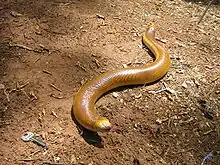Amphisbaenidae
The Amphisbaenidae, common name worm lizards, are a family of amphisbaenians, a group of limbless vertebrates.
| Amphisbaenidae | |
|---|---|
 | |
| Amphisbaena alba | |
| Scientific classification | |
| Kingdom: | Animalia |
| Phylum: | Chordata |
| Class: | Reptilia |
| Order: | Squamata |
| Clade: | Amphisbaenia |
| Family: | Amphisbaenidae Gray, 1865 |
| Genera | |
|
12 extant, see text | |
Geographic range
Amphisbaenids occur in South America, some Caribbean islands, and sub-Saharan Africa.
Taxonomy
One deep-branching and somewhat aberrant genus, Blanus, is native to Europe, and may represent a distinct family.[1] More recent sources indeed place it in the family Blanidae.[2]
Description
Members of the family Amphisbaenidae are limbless, burrowing lizards with carnivorous diets. As in other amphisbaenians, the body bears rings of scales, which gives amphisbaenids a worm-like appearance. The heads are massively constructed and used for burrowing, with powerful jaws and large, recurved teeth used for seizing prey. Some species have spade-like heads, while others have a narrow keel on their heads, and still others have a rounded skull.[1] The eyes are highly reduced, while the ear bone, or stapes in the middle ear, is large and massive. Together with another bone, the extracollumella, the stapes detects vibrations caused by prey items, allowing amphisbaenids to hunt for invertebrates under ground. In this respect, apparently evolution exists convergent to the burrowing mammalian family Chrysochloridae, in which the malleus in the middle ear is greatly enlarged.[3][4]
Genera
.JPG.webp)
Over 170 extant species are in the family, grouped into 12 genera:
- Amphisbaena Linnaeus, 1758
- Ancylocranium Parker, 1942
- Baikia Gray, 1865
- Chirindia Boulenger, 1907
- Cynisca A.M.C. Duméril & Bibron, 1839
- Dalophia Gray, 1865
- Geocalamus Günther, 1880
- Leposternon Wagler, 1824[5]
- Loveridgea Tornier, 1899
- Mesobaena Mertens, 1925
- Monopeltis A. Smith, 1848
- Zygaspis Cope, 1885
Fossil record
A number of extinct taxa are known from the fossil record:[6]
- †Campinosaurus
- †Listromycter
- †Lophocranion
- †Platyrhachis
References
- Gans C (1998). Cogger HG; Zweifel RG (eds.). Encyclopedia of Reptiles and Amphibians. San Diego: Academic Press. p. 216. ISBN 978-0-12-178560-4.
- Amphisbaenidae at the Reptarium.cz Reptile Database. Accessed 1 February 2017.
- Mason, Matthew J. (2003-08-01). "Morphology of the middle ear of golden moles (Chrysochloridae)". Journal of Zoology. 260 (4): 391–403. doi:10.1017/S095283690300387X. ISSN 1469-7998.
- Mason, Matthew J.; Narins, Peter M. (2001-01-01). "Seismic Signal Use by Fossorial Mammals". American Zoologist. 41 (5): 1171–1184. doi:10.1093/icb/41.5.1171. JSTOR 3884562.
- Ribeiro, Síria; Vaz-Silva, Wilian; Santos, Alfredo P., Jr. (2008). "New pored Leposternon (Squamata, Amphisbaenia) from Brazilian Cerrado". Zootaxa 1930: 18-38. ("Leposternon Wagler, 1824", p. 18).
- "Amphisbaenidae Gray 1865". Paleobiology Database. Fossilworks. Retrieved 1 February 2017.
Further reading
- Gans C (2005). "Checklist and Bibliography of the Amphisbaenia of the World". Bulletin of the American Museum of Natural History (289): 1-130.
External links
| Wikispecies has information related to Amphisbaenidae. |
